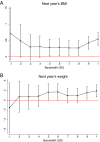Impacts of classifying New York City students as overweight
- PMID: 26976566
- PMCID: PMC4822590
- DOI: 10.1073/pnas.1518443113
Impacts of classifying New York City students as overweight
Abstract
US schools increasingly report body mass index (BMI) to students and their parents in annual fitness "report cards." We obtained 3,592,026 BMI reports for New York City public school students for 2007-2012. We focus on female students whose BMI puts them close to their age-specific cutoff for categorization as overweight. Overweight students are notified that their BMI "falls outside a healthy weight" and they should review their BMI with a health care provider. Using a regression discontinuity design, we compare those classified as overweight but near to the overweight cutoff to those whose BMI narrowly earned them a "healthy" BMI grouping. We find that overweight categorization generates small impacts on girls' subsequent BMI and weight. Whereas presumably an intent of BMI report cards was to slow BMI growth among heavier students, BMIs and weights did not decline relative to healthy peers when assessed the following academic year. Our results speak to the discrete categorization as overweight for girls with BMIs near the overweight cutoff, not to the overall effect of BMI reporting in New York City.
Keywords: BMI; Fitnessgram; New York City; childhood obesity; regression discontinuity design.
Conflict of interest statement
The authors declare no conflict of interest.
Figures
References
-
- Huang JS, et al. Parental ability to discriminate the weight status of children: Results of a survey. Pediatrics. 2007;120(1):e112–e119. - PubMed
-
- Katz DL. Oblivobesity: Looking over the overweight that parents keep overlooking. Child Obes. 2015;11(3):225–226. - PubMed
-
- Hoffman J. (June 16, 2015) Blind to a child's obesity. NY Times, p D1.
-
- Hunger JM, Tomiyama AJ. Weight labeling and obesity: A longitudinal study of girls aged 10 to 19 years. JAMA Pediatr. 2014;168(6):579–580. - PubMed
Publication types
MeSH terms
Grants and funding
LinkOut - more resources
Full Text Sources
Other Literature Sources


